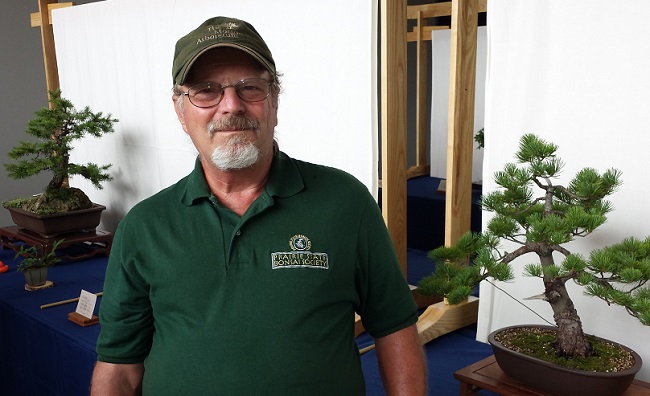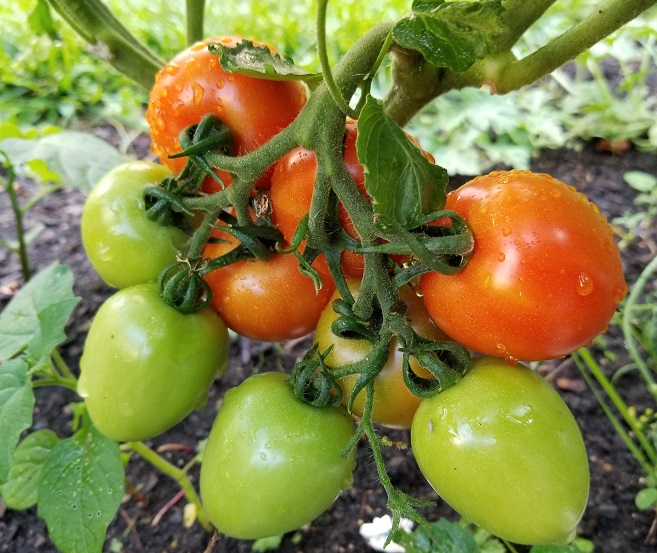Bonsai, Tomato and Native Plant Rock Stars
There’s a lot of gardening on today’s show, so strap in.
![]() (July 29, 2018) We start with the final day of the 6th annual GreenBuilt Home Tour. If you’re a fan of Mighty House Home Improvement Radio on 1590 WCGO, you probably heard Ron Cowgill and his team discussing the event on their show this weekend. Sponsored by the Illinois Green Alliance, the tour
(July 29, 2018) We start with the final day of the 6th annual GreenBuilt Home Tour. If you’re a fan of Mighty House Home Improvement Radio on 1590 WCGO, you probably heard Ron Cowgill and his team discussing the event on their show this weekend. Sponsored by the Illinois Green Alliance, the tour
features exceptional, award-winning, and nationally-recognized homes throughout Illinois, which highlight attractive, affordable, and sustainable building practices. During the annual two-day event, attendees learn ways the built environment contributes to a healthier community. The tour includes Illinois’ finest builders, designers and homeowners who have created healthy, energy saving green homes.
One of those homes is Evanston’s 1st LEED Platinum Home, located at 1426 Mulford St., Evanston, IL 60202. In addition to the features that make it sustainable (no natural gas connection, recycled materials, local materials and non-toxic materials), the yard features rain gardens created by Julia Bunn, who is also known at The Spirited Gardener.
Most of you have probably heard the phrase “rain garden,” though it’s pretty likely that you have never seen one, let alone created and maintained that kind of landscape feature. Prairie Rivers Network describes a rain garden as
a shallow, vegetated landscaping feature that captures rainwater and puts it to work. As the rain garden bed is slightly below the level of the yard, the garden acts as a shallow dish that holds the water for a short time so that it can soak into the garden soil. Well-designed rain gardens absorb 30% more water than turf lawns and will drain completely within a day after an average storm.
PRN notes that a rain garden can improve water quality by filtering polluted water that would otherwise go into storm drains and need to be treated. For similar reasons, they also promote water conservation.
Julia Bunn stops by the WCGO studios this morning before she heads off to the GreenBuilt Home Tour. We’ll talk about how you can determine whether you could benefit from a rain garden and then how to take the first steps to install one in your own yard.
The return of the Bonsai Guy.
If you’re a regular listener to the show (and who isn’t?), you know that that Dan Kosta has appeared many times on The Mike Nowak Show. He is a horticulturist who works for Vern Goers Greenhouse in Hinsdale, Illinois, and his job there is lot like his job on this radio show–to talk about gardening and answer questions.
 But if he’s on the show at this time of year, it’s likely because he’s wearing his hat as a member of the Prairie State Bonsai Society and he’s here to promote their annual show, which is part of the Destination Asia Festival at the Morton Arboretum. You can learn all about The Art of Bonsai, which includes displays and demonstrations by Prairie State Bonsai Society members, a chance to vote for your favorite bonsai of the show, and opportunities to purchase supplies from vendors.
But if he’s on the show at this time of year, it’s likely because he’s wearing his hat as a member of the Prairie State Bonsai Society and he’s here to promote their annual show, which is part of the Destination Asia Festival at the Morton Arboretum. You can learn all about The Art of Bonsai, which includes displays and demonstrations by Prairie State Bonsai Society members, a chance to vote for your favorite bonsai of the show, and opportunities to purchase supplies from vendors.
However, there’s a price to be paid for appearing on this show, which is not exactly a stiff price–I make him answer gardening questions. He wrote to me about the kinds of issues he’s seeing in Midwest gardens this year. I told him that my tomatoes seemed to be slow to develop this year and this was his response.
You are not alone with slow developing plants. Several customers have told me they are getting green tomatoes that are not ripening. Tomatoes and peppers like heat and we have been relatively cool this summer so they are not liking it. Same with geraniums that want heat to perform best. They are a semi-desert plant in Nature. Other annuals are also lagging.
Roses took a big hit last winter. Massive die back, or die out, has been common. I believe our long warm weather last Fall kept some woody plants from getting fully dormant. Dormancy is developed by alternating warm days and chilly nights which was not the case last Fall. I think there was water up in the stems and when we suddenly got colder the water froze and burst cells. Also happened with boxwood and Alberta spruce. A lot of Colorado spruce have dead tops due to the warmer and drier conditions that are occurring. Some trees have completely died. This is a species native to cool, moist mountain conditions and they are not liking the climate change.
Viburnum leaf beetles seem to be less of a problem this year. A lot of customers are buying milkweed for the Monarchs and parsley and dill for Black Swallowtail butterflies.
So there you go–a report from the front lines. I’m looking forward to talking to Dan.
Speaking of reports from the front lines…heeeeere’s KC Tomato!
I feel like I might be repeating myself here, but if you’re a regular listener to the show (and who isn’t?…wow, deja vu all over again), you know that one of our regular contributors on Twitter and Facebook is a guy named KC Tomato. Obviously, or not so obviously, that’s not his real name. It happens to be Keith Mueller. But he does happen to grow tomatoes–lots of them!–near Kansas City, Missouri. Hence, the name.
A few weeks ago, Peggy and I began noticing leaf curl on our tomato plants. Other folks reported the same condition, so we posted the information on social media to see if somebody might have a diagnosis. KC Tomato thought that it might be herbicide drift. This is basically how he tweeted the information to me;
 KC Tomato
KC Tomato
I only occasionally saw herbicide drift 20-25 years ago
KC Tomato
Recently I see much more
KC Tomato
Its because sales/marketing switch from amine based 2,4-D (more stable molecule, works slower) to ester based (highly volatilized into the air and kills faster)
KC Tomato
Ester based 2,4-D makes consumers happier but does far more damage because it drifts easier and plants are more sensitive because it breaks bond with the ester carrier easier.
KC Tomato
Ester based 2,4-D and 2,4,5-T and a few others, used to only be used by corn growers because ester based formulations work better in cooler weather when farmers sprayed.
KC Tomato
But they started putting them in herbicide mixes for broad spectrum killers (roadside, under power wires)
KC Tomato
Then the marketing people started selling it to home owners as a “quick kill” alternatives
KC Tomato
They upped the price too
KC Tomato
So
KC Tomato
The “If a hammer works a sledgehammer should work better logic” to home pest care applies
The Seed to Kitchen Collaborative, led by Julie Dawson, engages plant breeders, farmers and chefs to evaluate and co-create high quality vegetable varieties for organic production in the upper Midwest. Participants set priorities 12 common crops (beets, potato, sweet corn, cucumber, sweet pepper, hot pepper, tomato, melon, winter squash, lettuce, kale and bitter greens), and then evaluate submissions from breeders and seed companies throughout the season. Varieties are selected for the trial based on purported high quality in organic systems, good flavor, and lack of previous trialing in the Midwest.
The Collaborative evaluated over 70 varieties of tomatoes in its first three years. Some favorites came from Keith Mueller, an independent breeder in Missouri. Keith specializes in intensely flavored fruits in every color from bright yellow to the dark purple of his anthocyanin lines. He often incorporates a rare “apricot blush” gene into his lines, which gives a yellow fruit a red-orange “blush” around the base as it ripens.
Hokey smokes! KC Tomato is a rock star! Who knew?
Birds, Bees, & Butterflies: A Native Garden Tour
We talk about native plants a lot on this show, so you might as well have a chance to see some of them. That opportunity arises next Sunday, August 5, from 1:00 to 4:00 p.m. at Birds, Bees, & Butterflies: A Native Garden Tour, hosted by Wild Ones West Cook. There are seventeen (count ’em, 17!) native gardens and, as they ‘splain it,
This tour offers you an opportunity to visit private and public gardens in Oak Park and River Forest that are brimming with life and beauty. The host gardeners are excited to walk you through these treasured spaces. Each stop on the tour is unique, reflecting each gardener’s interests. You will see and hear about how these gardens are making important contributions to sustaining life on this planet.
Many of the plants on view are not widely known or used in gardens, so here’s your chance to learn about IL’s unique, under-used plants. Let’s develop a sense of place that reflects IL’s rich natural history heritage too.
Tickets are available HERE, and they are $7 for Wild Ones members (paid dues) or $10 for non-members. You can purchase tickets the day of event for $12 non-members and $10 for WIld Ones members at Oak Park Conservatory, 615 Garfield Street, Oak Park, IL, 60304. Children attend free.
This morning, we welcome citizen scientist Stephanie Walquist, who is vice-president of West Cook Wild Ones and who has a garden on the tour called “Biodiversity Bastion.” She is joined by Terry Guen, who is chief cook and silverware washer for Terry Guen Design Associates. Her garden is called “Old Friends Garden,” which is appropriate because I have known Terry for quite a few years.
This is a jam-packed show, and it’s going to be fun. If you can’t listen live, we hope you catch the podcast at www.mikenowak.net/podcasts.


